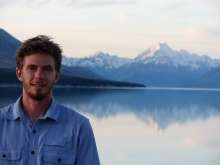Aaron Putnam
Address: 224 Bryand Global Sciences Center, University of Maine, Orono, ME 04469
Research Area:
I am interested in mechanisms of Late Quaternary climate change. In particular, the causes of the 100,000-yr glacial cycles of the past million years, and the abrupt climate switches that brought them to a close, remain fundamental outstanding problems. I am also interested in the underlying causes of natural climate variations over the Holocene, and their associations with the rise and fall of civilizations. The effects of ice ages, abrupt climate change, and Holocene climate variability have been imprinted on the landscape by Earth’s mountain glaciers, ice sheets, and pluvial lake systems. I am attempting to construct the evolution of these climate switches by developing precise chronologies of glacier and pluvial lake activity in the middle latitudes of the polar hemispheres. I use surface-exposure and radiocarbon dating techniques to construct chronologies of glacial landforms that mark past extents of mountain glaciers and ice sheets. Working together with Sean Birkel, I employ geometrical snowline reconstruction and glaciological modeling techniques to derive quantitative paleoclimatic information from glacier landforms. We are interested in how abrupt climate anomalies are transmitted between the hemispheres during glacial terminations, and more recently during Medieval time and the ‘Little Ice Age’. We are also interested in the role of radiative forcing in glacial cycles. For example, we are currently merging our glacial chronology data from the western United States and interior Asia with glaciological and energy-balance modeling to derive the role of total radiative forcing in producing Northern Hemisphere glaciations. A solution to this problem can inform regional solutions for the sensitivity of atmospheric temperatures to elevated atmospheric CO2 concentrations.
Another fundamental problem of climate research involves how Earth’s water resources will respond to global warming, as well as future natural climate variations. In this regard, I work with a team from the University of Nevada, Reno, led by Professor Douglas Boyle, as well as John Chiang at UC Berkeley, to merge paleohydrological lake-level information with sophisticated hydrological modeling in order to assess (1) how dryland hydroclimates responded to past climate shifts, and (2) potential impacts of ongoing and future warming on water resources in Northern Hemisphere drylands. Sean Birkel is also involved in this effort. We are integrating paleohydrological solutions with our mountain glacier research to deconvolve atmospheric temperature and precipitation evolution of the western United States and interior Asia since the last ice age.
Field areas include:
Southern Alps, New Zealand (with George Denton and Joerg Schaefer)
Patagonian Andes (with Charlie Porter, Brenda Hall, George Denton, and Tom Lowell)
Rocky Mountains and Sierra Nevada, western USA (with Sean Birkel, David Putnam, George Denton, Joerg Schaefer, Doug Boyle, Scott Bassett)
Tarim Basin, Xinjiang, China (with Wally Broecker, George Denton, David Putnam, Chunzeng Wang, Ed Cook, and Jonathan Palmer)
Mongolian Altai (with Olaf Jensen, David Putnam, and Joerg Schaefer)
Bhutan Himalaya (with Joerg Schaefer, Ed Cook, and Summer Rupper)
Scottish Highlands (with Gordon Bromley and Kurt Rademaker)
Western Norway (with Bjørn Andersen)
Switzerland (with Joerg Schaefer)
Midwestern United States (with Tom Lowell)
Previous field areas: northern Maine, northern Alaska, the Canadian Arctic Archipelago, and the Transantarctic Mountains, Antarctica.


